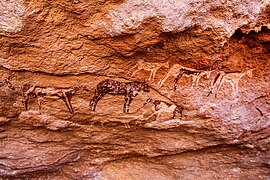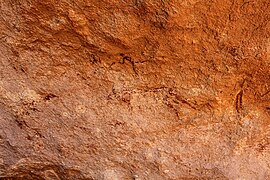 Maghārat el-Qanṭara | ||
| Maghārat el-Qanṭara · مغارة القنطرة | ||
| no tourist info on Wikidata: | ||
| ||
Magharat el-Qantara (also MagharatMagharet / Magaret el-Qantara, Mogharat el-Kantara, Qantara cave, Arabic:مغارة القنطرة, Maghārat al-Qanṭara, „vaulted cave“, Shaw’s Cave (Arabic:كهف تشاو) Or Rupert’s Cave is a cave with rock paintings in the southeastern part of the Gilf Kebir Plateaus, the Kamal-ed-Din plateau. To this day it is the only known prehistoric rock depiction in the Kamal-ed-Din plateau.
background
In January 1935 by the desert explorer William Boyd Kennedy Shaw (also Bill Kennedy Shaw, 1901–1979) and by the brigadier Rupert Harding-Newman (1907–2007) discovered cave with its rock paintings is located in the south of the Kamal-ed-Din plateau on a promontory that separates Wādī el-Firāq in the west from Wādī Wasʿ (Wadi Wassa) in the east. Nothing comparable has been found along this plateau to this day. Possibly it came from passing through.
But it was not the first discovery of its kind that Kennedy Shaw made. As a forester in Sudan since 1923, he explored and mapped the area between the Merga Depression and Selima. He later gave up the job to devote himself to archeology. He participated in several expeditions of the desert explorer Ralph Alger Bagnold (1896-1990). Among his discoveries are rock carvings at castle el-Tuyūr (bird tower) and in Wadi Hawar. In 1940 Bagnold brought him to the one he had founded Long Range Desert Group the British Army. Shaw published a book about this special unit in 1945.[1]
getting there
Visiting the 1 cave(22 ° 58 ′ 56 ″ N.25 ° 59 ′ 11 ″ E) is usually part of a desert excursion to the Gilf Kebir National Park. An all-terrain four-wheel drive vehicle is required to travel through the desert.
The memorial can be reached via the intermediate stations Samīr Lāmā rock, Abū Ballāṣ and Eight Bells.
A permit from the Egyptian military is required to drive into the national park. During the trip you will be accompanied by armed police officers and a military officer. For trips to the Gilf Kebir there is a separate safari department in Mū,, which also provides the necessary police escort and their vehicles. The mandatory service is of course chargeable.
Tourist Attractions
The rock paintings of Maghārat el-Qanṭara are under an overhanging rock. The cave thus formed is about four meters high and 15 meters wide.
About half a meter above the ground one discovers the representations of a herd of differently drawn cattle and a farm. The age of these drawings is estimated to be around 8,000 years.

Rock carving of a homestead

Cattle as a rock carving

Shepherds with cattle
kitchen
You can rest outside the cave. Food and drinks must be brought along. Rubbish must be taken with you and must not be left lying around.
accommodation
Tents must be carried for overnight stays at some distance.
trips
The rock group and the British military airport are located about 40 kilometers to the south-east Eight Bells. In between there is an archaeological find area 2 Archaeological area near the 8 Bells(22 ° 39 ′ 1 ″ N.26 ° 13 '40 "E) with prehistoric artifacts (more under Eight Bells).
The cave can also be used as a starting point for visits to various wadis in the east of the Gilf Kebir Plateaus like that Wādī el-Bacht or des Monument to Prince Kamal ed-Din use.
literature
- : Rock Paintings in the Libyan Desert. In:Antiquity: a quarterly review of world archeology, ISSN0003-598X, Vol.10,38 (1936), Pp. 175–178, doi:10.1017 / S0003598X00011558.
- : Magharat el-kantara (Shaw’s Cave) revisite: art rupstre du sud Gilf Kebir (Egypte de sud-ouest). In:Sahara: preistoria e storia del Sahara, ISSN1120-5679, Vol.9 (1997), Pp. 124-133.
Individual evidence
- ↑: Long Range Desert Group: the story of its work in Libya; 1940-1943. London: Collins, 1945. Reproduction from Greenhill Books in London, 2000, ISBN 978-1853674075 .




